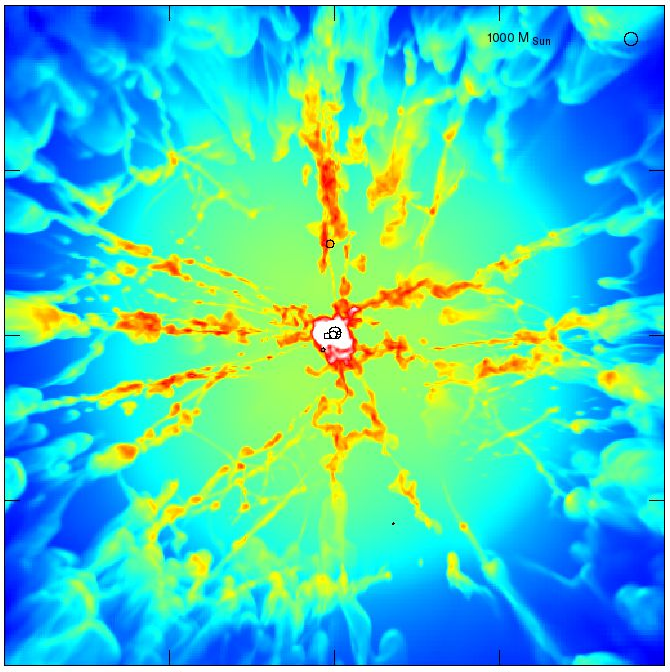Massive star clusters
Young massive star clusters are rare: there are only about ten young star clusters more massive than 104 solar masses in our Galaxy, and clusters with masses higher than 105 M☉ have been found only in external galaxies. Therefore, there are still many open questions and mysteries related to these objects. We study young massive star clusters, focusing on the role of the feedback from massive stars, i.e. the effects of radiation, stellar winds and supernova explosions on cluster formation and evolution. We are interested in the physical processes taking place in the hot gas in the young cluster interior, which originates from strong shocks formed by collisions of stellar winds and supernova ejecta. In particular, we are interested in the effects of strong radiative cooling which leads to thermal instability and the formation of dense warm clumps. We also include cooling due to the dust produced by supernovae and embedded in the hot gas.

R136 in Large Magellanic Cloud (the most massive young star cluster in the Local group). Credit: NASA, ESA (HST)

RHD simulation with secondary star formation in a young massive cluster.

Galactic globular cluster M15. Credit: NASA, ESA (HST)
A particularly interesting problem is the relation between young massive star clusters and old globular clusters. It has been found that globular clusters consist of several population of stars which differ in their chemical composition. Moreover, spectroscopy of red giants in globular clusters has revealed very unusual chemical patterns that are not observed in any other known objects, which possibly resulted from the burning of hydrogen at high temperatures (through the CNO cycle, NeNa cycle and other reactions). Several scenarios of the formation of globular clusters have been suggested, often considering the mechanism of self-enrichment, in which more enriched stars are formed out of winds and outflows of previous stellar generations. However, many questions about the origin of globular clusters still remain open. In collaboration with INAOE in Puebla, Mexico, we develop the model of rapidly cooling shocked stellar winds that aims to address the question of the origin of multiple stellar populations in globular clusters.
Methods:
Our main research tools are numerical and semi-analytic codes, combined with archival data and our own observations. We develop the radiation-hydrodynamic model based on the public code Flash, supplemented with several modules we help develop. In particular, we develop in collaboration with the Theoretical Astrophysics Group at Cologne University the radiation transport code TreeRay. The semi-analytic code Windcalc (describing a spherically symmetric stationary star cluster wind) is used for fast exploration of the parameter space. Observationally, we mainly rely on data from the literature and archives. However, we also have our own data taken with the FEROS spectrograph on the 2.2m telescope on La Silla, and we also participate in observations with ESO VLT.
Scientific questions we are interested in:
- How did globular clusters (including their multiple populations) form?
- What is the star formation efficiency in case of massive star clusters?
- Where is the missing energy of stellar winds (not visible in Xray hot gas)?
- What determines whether a star cluster survives or not?
- Do massive star clusters form with a top-heavy IMF?
References:
- Martínez-González, Sergio; Wünsch, Richard; Palouš, Jan, 2017, ApJ 843, 95:
Can Dust Injected by SNe Explain the NIR-MIR Excess in Young Massive Stellar Clusters? - Recchi, S.; Wünsch, R.; Palouš, J.; Dinnbier, F., 2017, Ap&SS 362, 183:
Globular Cluster formation in a collapsing supershell - Wünsch, R.; Palouš, J.; Tenorio-Tagle, G.; Ehlerová, S., 2017, ApJ 835, 60:
The Formation of Secondary Stellar Generations in Massive Young Star Clusters from Rapidly Cooling Shocked Stellar Winds - Palouš, J.; Wünsch, R.; Tenorio-Tagle, G., 2014, ApJ 792, 105:
On the Onset of Secondary Stellar Generations in Giant Star-forming Regions and Massive Star Clusters - Wünsch, R.; Tenorio-Tagle, G.; Palouš, J.; Silich, S., 2008, ApJ 683, 683:
Two-dimensional Hydrodynamic Models of Super Star Clusters with a Positive Star Formation Feedback - Tenorio-Tagle, Guillermo; Wünsch, Richard; Silich, Sergiy; Palouš, Jan, 2007, ApJ 658, 1196:
Hydrodynamics of the Matter Reinserted within Super Stellar Clusters